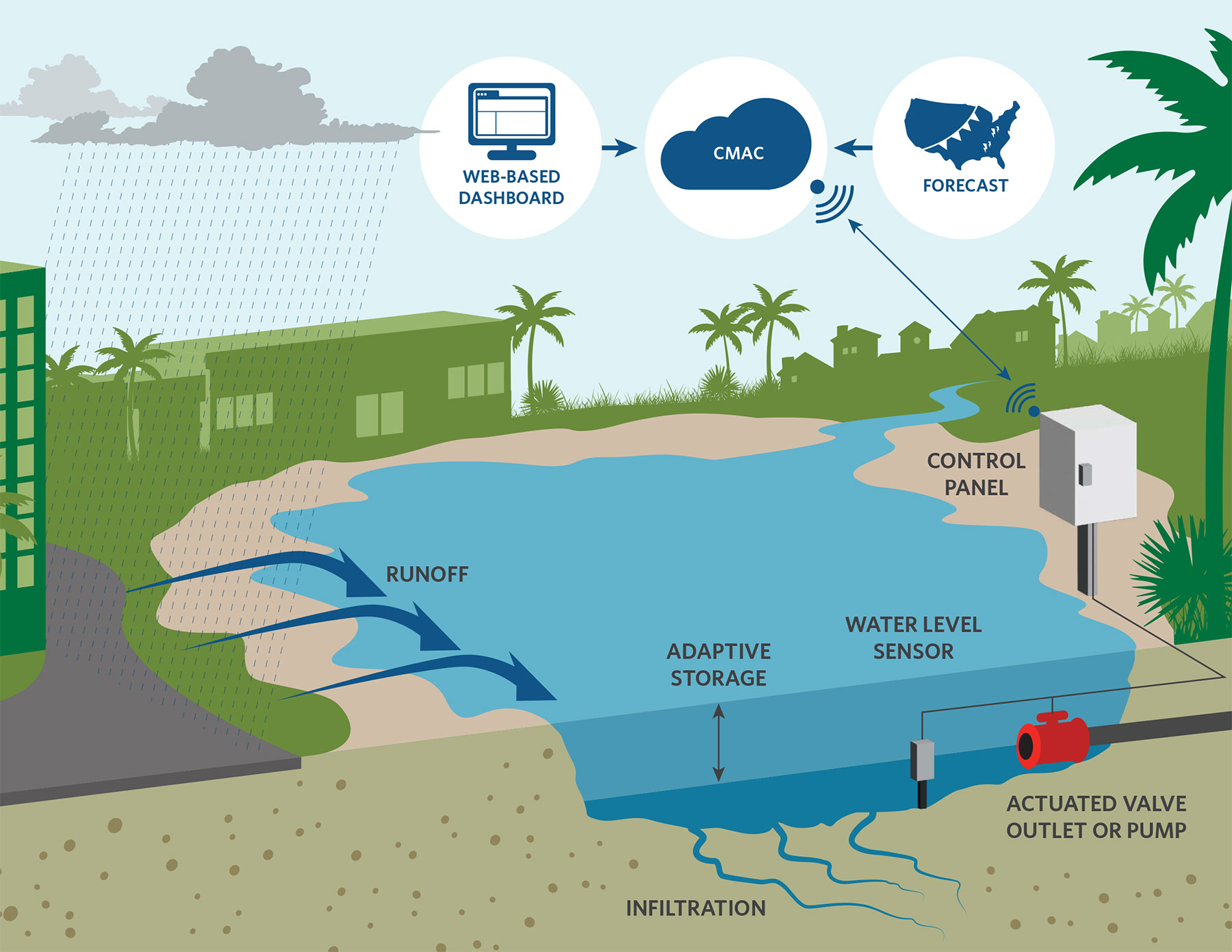Stormwater, including urban runoff, is a leading cause of water pollution, and it oftentimes exacerbates flooding and erosion.
In the U.S., at least 90 percent of land in urban and suburban areas is privately owned, yet most investments in surface water management are managed within the public sector. This leaves just 10 percent or less readily available for impactful, publicly funded stormwater infrastructure improvements. This underscores the need for public-private partnerships to produce viable solutions to address—at scale—the impacts of stormwater. With this in mind, The Nature Conservancy (TNC) created the Brightstorm program.
TNC’s Brightstorm program facilitates public-private partnerships to demonstrate how emerging technologies can improve the environmental outcomes of existing stormwater infrastructure. We test new technologies, then collaborate with the public sector to work toward achieving water quality goals.
Smart Stormwater Ponds
While innovative, the ‘smart’ pond concept is relatively simple. Using cloud-based technology, existing stormwater ponds are retrofitted with continuously monitored water-level sensors that control automated release valves based on real-time weather forecasts. By using this information, smart ponds anticipate how much storage is required at any given moment, for any given forecasted storm event. This enables the ponds to hold runoff longer, which removes more nutrients and improves water quality, and to lower water levels ahead of storms to produce more flood storage capacity. Also, lower flow rates from smart ponds better mimic natural hydrological conditions, reducing erosion and enhancing wildlife habitat.


Smart Watershed Network Management (SWNM)
Based on 10 years of data and analysis that proves the ability of smart ponds to generate enhanced environmental benefits, we believe this technology is ready for its next evolution. With the aid of Artificial Intelligence (AI) and Machine Learning (ML), we can create a collection of smart ponds that receive and share real-time data within a common network to optimize performance. We call this approach Smart Watershed Network Management, or SWNM.
SWNM Pilot Project in the Indian River Lagoon
Within the Indian River Lagoon watershed, there are more than 10,000 stormwater ponds. Brightstorm is working with policy experts, world-renowned engineering firms and leading AI/ML software companies to create the world’s first AI/ML-driven SWNM installation where it matters most.
The Indian River Lagoon (IRL) is one of North America’s most biologically rich estuaries—and seagrasses are its lifeblood. Seagrass beds provide critical habitat for a wide array of fish and shellfish, which in turn sustain valuable commercial and residential fisheries as well as birds, dolphins and other species.
Excess nutrients—often carried by stormwater—affect seagrass health, as these pollutants fuel algal overgrowth which reduces sunlight penetration through the water column. Since 2009, experts estimate that portions of the IRL have lost as much as 69% of its seagrass beds.
The Florida Department of Environmental Protection (DEP) recognizes seagrass as a keystonespecies, meaning it is critical for the overall structure and function of Florida’s estuaries.

To protect and restore seagrass beds in the IRL, the DEP has set Total Maximum Daily Loads, requiring significant reduction in nutrients entering the Lagoon.
SWNM Pilot Project Plans
In the initial phase of the project, TNC will develop the SWNM AI/ML tools and select pilot sites. Next, we will implement up to a dozen smart pond pilot sites—in close proximity—to test and verify SWNM functionality and quantify environmental benefits, generating a body of science that can influence policy, community engagement and large-scale planning. With knowledge collected from the initial pilot sites, we will then replicate SWNM at additional priority locations and leverage historic levels of public infrastructure funding to expand the network of connected sites.
At the end of the pilot, we expect that SWNM will:
- Demonstrate that advances in software, artificial Intelligence, machine learning and adaptable control of water can lead to better environmental outcomes.
- Publish in a peer-reviewed scientific journal; achieve consensus on efficacy of approach.
- Provide training resources for future adoption.
- Create open-source tools and methodologies that are accessible and free for all public agencies throughout the U.S.
In the longer term, we believe our SWNM approach will create enabling conditions that lead to hundreds of connected smart ponds that treat billions of gallons of runoff that flows into the IRL and watersheds throughout Florida. We also see the potential for the SWNM concept to be integrated into regional watershed planning processes and used for implementing projects across Florida, the U.S. and beyond.
For more information, contact us at brightstorm@tnc.org.

